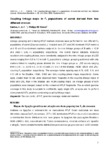Por favor, use este identificador para citar o enlazar este ítem:
http://www.alice.cnptia.embrapa.br/alice/handle/doc/128418Registro completo de metadatos
| Campo DC | Valor | Lengua/Idioma |
|---|---|---|
| dc.contributor.author | SANTOS, C. A. F. | pt_BR |
| dc.contributor.author | SIMON, P. W. | pt_BR |
| dc.date.accessioned | 2011-04-09T19:46:37Z | - |
| dc.date.available | 2011-04-09T19:46:37Z | - |
| dc.date.created | 2002-09-06 | pt_BR |
| dc.date.issued | 2002 | pt_BR |
| dc.identifier.citation | Horticultura Brasileira, Brasília, DF v. 20, n. 2, jul. 2002. | pt_BR |
| dc.identifier.uri | http://www.alice.cnptia.embrapa.br/alice/handle/doc/128418 | pt_BR |
| dc.description | Linkage grouping and ordering AFLP markers analyses were performed for two different F2 populations of carrot (Daucus carota L.). Included were 277 and 242 dominant AFLP markers and 10 and 8 co-dominant markers assigned to the nine linkage groups of Brasilia x HCM and B493 x QAL F2 populations, respectively. The overall marker datasets, includjng repulsion and coupling phases, were consistently assigned to the nine linkage groups at LOD scores ranging from 3.5 to 5.0 in both F2 populations. Linkage grouping performed with only markers linked in coupling phase showed the nine linkage groups at LOD scores ranging from 3.0 to 7.5, 3.0 to 5.5, 3.5 to 5.0 and 2.5 to 8.5 in the Brasilia-, HCM-, B493- and QAL- coupling F2 population, respectively. The average marker spacing was 4.78, 4.80, 5.54 and 5.13 cM in the Brasilia-, HCM-, B493 and QAL-coupling phase maps, respectively. Some gaps, greater than 10 cM, were observed more frequently in the coupling linkage maps of B493 and QAL than in the Brasilia- and HCM-coupling maps. Six linkage groups of both populations were merged, based on the conserved AFLP fragments .The excellent genome coverage in this study is suitable to confidently apply single QTL analysis and to perform more powerful QTL analysis considering coupling linkage maps. | pt_BR |
| dc.format | 1 CD-ROM. | pt_BR |
| dc.language.iso | eng | eng |
| dc.rights | openAccess | eng |
| dc.subject | AFLP | pt_BR |
| dc.subject | Melhoramento genético | pt_BR |
| dc.title | Coupling linkage maps in F2 populations of carrot derived from two different crosses. | pt_BR |
| dc.type | Artigo em anais e proceedings | pt_BR |
| dc.date.updated | 2017-11-09T11:11:11Z | pt_BR |
| dc.subject.thesagro | Cenoura | pt_BR |
| dc.subject.thesagro | Marcador molecular | pt_BR |
| dc.subject.thesagro | Daucus Carota | pt_BR |
| dc.subject.thesagro | Genética Molecular | pt_BR |
| dc.subject.thesagro | Genoma | pt_BR |
| dc.subject.thesagro | Marcador Genético | pt_BR |
| dc.subject.nalthesaurus | Carrots | pt_BR |
| dc.subject.nalthesaurus | Genetic markers | pt_BR |
| dc.subject.nalthesaurus | genome | pt_BR |
| dc.description.notes | Suplemento 2. Edição do 42 Congresso Brasileiro de Olericultura; 11 Congresso Latino Americano de Horticultura, Uberlândia, jul. 2002. | pt_BR |
| riaa.ainfo.id | 128418 | pt_BR |
| riaa.ainfo.lastupdate | 2017-11-09 -02:00:00 | pt_BR |
| dc.contributor.institution | CARLOS ANTONIO FERNANDES SANTOS, CPATSA. | pt_BR |
| Aparece en las colecciones: | Artigo em anais de congresso (CPATSA)  | |
Ficheros en este ítem:
| Fichero | Descripción | Tamaño | Formato | |
|---|---|---|---|---|
| OPB764.pdf | 265,05 kB | Adobe PDF |  Visualizar/Abrir |









